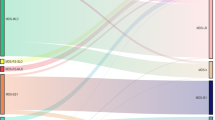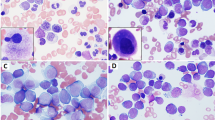Abstract
Myelodysplastic syndrome (MDS) is a clonal hematopoietic stem cell disorder characterized by ineffective hematopoiesis and leukemia progression. Racial differences may exist on clinical pictures and the molecular events leading to MDS, which are heterogeneous. To better define the clinical and cytogenetic features in Chinese patients, a retrospective multicentric study was performed in 508 MDS cases. Compared with Western countries, Chinese patients showed younger age (median: 49 vs 65–73 years), lower percentages of RARS (2.8 vs 6.6–15.3%), and CMML (5.2 vs 11.7–30.6%). Cytogenetically, among 367 cases with evaluable data, abnormal karyotypes were found in 136 cases, including 56 numerical and 80 structural changes. Incidences of single chromosome 5 and 7 abnormalities were lower than those in Western countries (2.2 vs 17.8–42.5%). However, complex cytogenetic aberrations and chromosome translocations were frequently observed and related to poor prognosis. Both multiple chromosome deletions and translocations were detected in advanced subtypes (RAEB and RAEB-T). Analysis of 200 cases revealed a higher incidence of hepatitis-B-virus infection than that in non-MDS population (21.00 vs 9.75%). This study further confirmed: (1) different genetic/environmental backgrounds between Asian and Western MDS populations; (2) a strong predictive value of cytogenetic abnormalities on disease outcome and involvement of genomic instability in leukemia clone development.
This is a preview of subscription content, access via your institution
Access options
Subscribe to this journal
Receive 12 print issues and online access
$259.00 per year
only $21.58 per issue
Buy this article
- Purchase on Springer Link
- Instant access to full article PDF
Prices may be subject to local taxes which are calculated during checkout




Similar content being viewed by others
References
Heaney ML, Golde DW . Myelodysplasia. N Engl J Med 1999; 340: 1649–1660.
Morel P, Hebbar M, Lai JL, Duhamel A, Preudhomme C, Wattel E et al. Cytogenetic analysis has strong independent prognostic value in de novo myelodysplastic syndromes and can be incorporated in a new scoring system: a report on 408 cases. Leukemia 1993; 7: 1315–1323.
Toyama K, Ohyashiki K, Yoshida Y, Abe T, Asano S, Hirai H et al. Clinical implications of chromosomal abnormalities in 401 patients with myelodysplastic syndromes: a multicentric study in Japan. Leukemia 1993; 7: 499–508.
Greenberg P, Cox C, LeBeau MM, Fenaux P, Morel P, Sanz G et al. International scoring system for evaluating prognosis in myelodysplastic syndromes. Cytogenetics of myelodysplastic syndromes. Blood 1997; 89: 2079–2088.
Lee JH, Shin YR, Lee JS, Kim WK, Chi HS, Park CJ et al. Application of different prognostic scoring systems and comparison of the FAB and WHO classifications in Korean patients with myelodysplastic syndrome. Leukemia 2003; 17: 305–313.
Bennett JM, Catovsky D, Daniel MT, Flandrin G, Galton DA, Gralnick HR et al. Proposals for the classification of the myelodysplastic syndromes. Br J Haematol 1982; 51: 189–199.
ISCN Guidelines for cancer cytogenetics. Supplement to: An International System for Human Cytogenetic Nomenclature. Basel: S Karge, 1995.
Hellstrom-Lindberg E, Willman C, Barrett AJ, Saunthararajah Y . Achievements in understanding and treatment of myelodysplastic syndromes. Hematology (Am Soc Hematol Educ Program) 2000, 110–132.
Suciu S, Kuse R, Weh HJ, Hossfeld DK . Results of chromosome studies and their relation to morphology, course, and prognosis in 120 patients with de novo myelodysplastic syndrome. Cancer Genet Cytogenet 1990; 44: 15–26.
Pfeilstocker M, Reisner R, Nosslinger T, Gruner H, Nowotny H, Tuchler H et al. Cross-validation of prognostic scores in myelodysplastic syndromes on 386 patients from a single institution confirms importance of cytogenetics. Br J Haematol 1999; 106: 455–463.
Lee DS, Kim SH, Seo EJ, Park CJ, Chi HS, Ko EK et al. Predominance of trisomy 1q in myelodysplastic syndromes in Korea: is there an ethnic difference? A 3-year multi-center study. Cancer Genet Cytogenet 2002; 132: 97–101.
Oguma S, Yoshida Y, Uchino H, Maekawa T, Nomura T, Mizoguchi H . Clinical characteristics of Japanese patients with primary myelodysplastic syndromes: a co-operative study based on 838 cases. Anemia Study Group of the Ministry of Health and Welfare. Leuk Res 1995; 19: 219–225.
Intragumtornchai T, Prayoonwiwat W, Swasdikul D, Suwanwela N, Chaimongkol B, Jootar S et al. Myelodysplastic syndromes in Thailand: a retrospective pathologic and clinical analysis of 117 cases. Leuk Res 1998; 22: 453–460.
Matsushima T, Handa H, Yokohama A, Nagasaki J, Koiso H, Kin Y et al. Prevalence and clinical characteristics of myelodysplastic syndrome with bone marrow eosinophilia or basophilia. Blood 2003; 101: 3386–3390.
Willman CL . Molecular genetic features of myelodysplastic syndromes (MDS). Leukemia 1998; 12 (Suppl 1): S2–S6.
Borrow J, Shearman AM, Stanton Jr VP, Becher R, Collins T, Williams AJ et al. The t(7;11)(p15;p15) translocation in acute myeloid leukaemia fuses the genes for nucleoporin NUP98 and class I homeoprotein HOXA9. Nat Genet 1996; 12: 159–167.
Hatano Y, Miura I, Nakamura T, Yamazaki Y, Takahashi N, Miura AB . Molecular heterogeneity of the NUP98/HOXA9 fusion transcript in myelodysplastic syndromes associated with t(7;11)(p15;p15). Br J Haematol 1999; 107: 600–604.
Kroon E, Thorsteinsdottir U, Mayotte N, Nakamura T, Sauvageau G . NUP98-HOXA9 expression in hemopoietic stem cells induces chronic and acute myeloid leukemias in mice. EMBO J 2001; 20: 350–361.
Raza-Egilmez SZ, Jani-Sait SN, Grossi M, Higgins MJ, Shows TB, Aplan PD . NUP98-HOXD13 gene fusion in therapy-related acute myelogenous leukemia. Cancer Res 1998; 58: 4269–4273.
Okuda T, Cai Z, Yang S, Lenny N, Lyu CJ, van Deursen JM et al. Expression of a knocked-in AML1-ETO leukemia gene inhibits the establishment of normal definitive hematopoiesis and directly generates dysplastic hematopoietic progenitors. Blood 1998; 91: 3134–3143.
Kojima K, Omoto E, Hara M, Sasaki K, Katayama Y, Nawa Y et al. Myelodysplastic syndrome with translocation (8;21): a distinct myelodysplastic syndrome entity or M2-acute myeloid leukemia with extensive myeloid maturation? Ann Hematol 1998; 76: 279–282.
Yoneda-Kato N, Fukuhara S, Kato J . Apoptosis induced by the myelodysplastic syndrome-associated NPM-MLF1 chimeric protein. Oncogene 1999; 18: 3716–3724.
Wang L, Ogawa S, Hangaishi A, Qiao Y, Hosoya N, Nanya Y et al. Molecular characterization of the recurrent unbalanced translocation der(1;7)(q10;p10). Blood 2003; 102: 2597–2604.
Acknowledgements
This work was supported in part by the National High Tech Program (863), the Chinese National Key program for Basic Research (973), National Natural Science Foundation of China, Shanghai Commission for Science and Technology, Shanghai Leading Academic Discipline and the Samuel Waxman Cancer Research Foundation. We thank Ting-Xi Liu for helpful suggestions of the manuscript, Min Zhang, Li-Quan Fan for technical assistance, and Yu Liu, Zhao-Jun Wen for illustrations.
Author information
Authors and Affiliations
Corresponding author
Rights and permissions
About this article
Cite this article
Chen, B., Zhao, WL., Jin, J. et al. Clinical and cytogenetic features of 508 Chinese patients with myelodysplastic syndrome and comparison with those in Western countries. Leukemia 19, 767–775 (2005). https://doi.org/10.1038/sj.leu.2403688
Received:
Accepted:
Published:
Issue Date:
DOI: https://doi.org/10.1038/sj.leu.2403688
Keywords
This article is cited by
-
Validation of the molecular international prognostic scoring system in patients with myelodysplastic syndromes defined by international consensus classification
Blood Cancer Journal (2023)
-
Oral Arsenic-Containing Qinghuang Powder: A Potential Drug for Myelodysplastic Syndromes
Chinese Journal of Integrative Medicine (2022)
-
Clinico-Hematological and cytogenetic spectrum of adult myelodysplastic syndrome: The first retrospective cross-sectional study in Iranian patients
Molecular Cytogenetics (2021)
-
Incorporation of mutations in five genes in the revised International Prognostic Scoring System can improve risk stratification in the patients with myelodysplastic syndrome
Blood Cancer Journal (2018)
-
Clinicohematological and cytogenetic profile of myelodysplastic syndromes in Pakistan-compare and contrast
Molecular Cytogenetics (2017)



